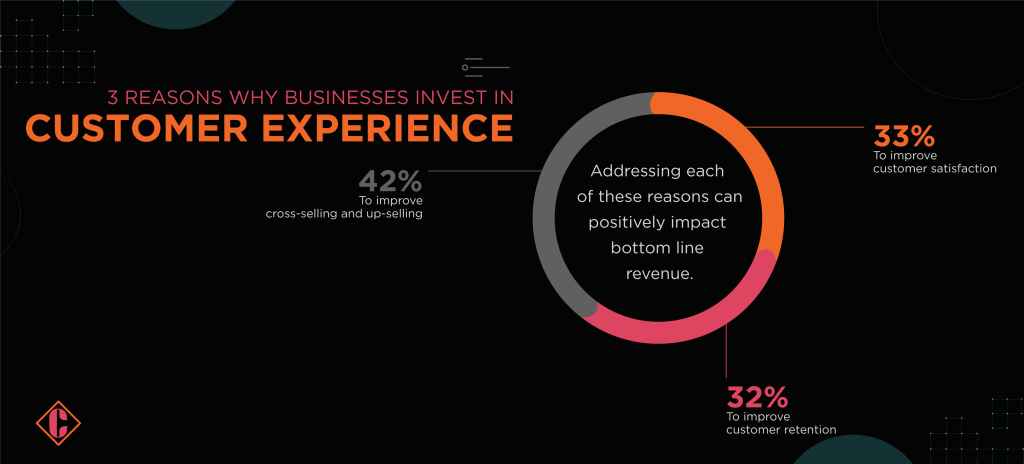Delivering exceptional customer experiences stands as a cornerstone for enduring customer engagement. Adapting to evolving needs and expectations mandates a precise orchestration of information, services, and products tailored to each moment’s demand. It’s a multifaceted approach, oscillating between empowering customers for self-service and providing substantial aid during critical junctures.

The customer experience landscape (CX) has transcended its traditional confines of customer-facing teams. The pivotal role of the Chief Information Officer (CIO), responsible for furnishing the systems and tools essential for stellar experiences, has taken center stage. The recent shift towards prioritizing CX reflects its integral status in today’s digital realm.
The CIO’s evolving role reflects the increasing impact of customer experience. CIOs face challenges such as securing and accelerating connections and ensuring data integrity in a remote work culture. As CIO responsibilities shift toward digital adoption, especially in B2B SaaS companies, a new imperative arises: seamlessly integrating customer experience into the organization’s fabric. This transformation highlights the growing synergy between technology leadership and customer-centric strategies.
According to recent findings by SuperOffice, nearly half of businesses, standing at 45.9%, have earmarked CX as their foremost priority over the next half-decade. The significance of this focus is underscored by its direct correlation with revenue growth. Studies by the Temkin Group reveal a compelling association: companies generating $1 billion annually can anticipate an average surge of $700 million within three years of investing in CX initiatives.
The potential dividends from CX investments are even more lucrative for SaaS enterprises. SuperOffice reports a staggering possible revenue increment of $1 billion attributed to CX investments within this sector. The avenues through which CX fosters revenue escalation are multifaceted.
 A superior customer experience tends to prompt increased customer expenditure, as statistics indicate that 86% of buyers are willing to shell out more for exceptional service.
A superior customer experience tends to prompt increased customer expenditure, as statistics indicate that 86% of buyers are willing to shell out more for exceptional service.
Moreover, PWC’s research emphasizes a correlation between the cost of an item and the premium customers are willing to pay for an enhanced experience. The attractiveness of CX extends to spur impulse purchases, with 49% of buyers making unplanned purchases following a personalized experience. In strategizing for 2024, acknowledging and leveraging these key customer experience statistics and emerging trends remains crucial to harnessing the potential of CX as a core driver of success.
3 Reasons Businesses Invest in Customer Experience
Customer experience has emerged as the frontline differentiator in today’s marketplace. Companies recognizing its pivotal role prioritize it, with a staggering 88% focusing on enhancing CX within their contact centers. The impact of a positive interaction resonates profoundly, influencing future purchasing decisions. With over two-thirds of companies competing primarily on CX, the imperative to stand out becomes evident. However, despite its critical significance, a concerning statistic looms: less than half of all organizations plan to increase their investment in CX initiatives next year, indicating a prevalent gap in acknowledging its value.
 1. Data-Driven Insights: The Foundation of Success
1. Data-Driven Insights: The Foundation of Success
Successful CX initiatives start with robust mechanisms to collect and analyze customer feedback. Gartner’s research emphasizes this pivotal starting point, urging companies to delve into customer comments, suggestions, and opinions garnered through surveys, web forms, or Net Promoter Score (NPS) programs. Addressing these expectations through targeted projects becomes paramount to meeting and exceeding customer demands.
2. Omnichannel Engagement: Consistency Across Channels
The contemporary consumer navigates myriad interaction channels, from website forms to social media and live chats. This necessitates companies to provide consistent experiences across these channels, commonly called omnichannel engagement. IKEA’s global consistency across its stores and digital platforms is a prime example, reflecting the benefits of substantial investments in CX. Reports indicate a significant surge of companies—now exceeding 80%—investing in the omnichannel experience, driven by promising outcomes such as increased revenues and customer satisfaction.
3. Mobile-Centric Focus: Prioritizing Accessibility
The mobile landscape has evolved into a pivotal arena for customer interaction, influencing brand perception significantly. Businesses that neglect mobile optimization risk losing customer trust and impeding growth potential. Statistics highlight this reality, with 84% of customer-centric companies directing efforts towards mobile CX. However, while platforms like WordPress or HubSpot offer tools for mobile optimization, a staggering 90% of customers report unsatisfactory experiences seeking support on mobile devices, underscoring the urgency for improvement in this domain.
Must-know CX Trends of 2024 and Beyond
Integration of Generative AI in CX Strategies
Generative AI, despite its substantial hype, remains a developing addition to the business portfolio. However, there will be a surge in organizations comprehending its precise value proposition in the upcoming years. Its applicability spans various fronts within the realm of CX, presenting boundless opportunities. From crafting dynamic marketing campaigns and tailoring user guides to optimizing customer service operations and delving deeper into behavioral data for comprehensive customer insights and loyalty enhancement, the potential of Generative AI is extensive.
As this technology integrates further into CX strategies, the imperative of maintaining unwavering transparency and ethical usage practices will elevate in significance. Upholding honesty in its deployment will become a linchpin in acquiring and retaining customer trust, thereby delineating the successful utilization of Generative AI in enhancing the customer experience.
Advanced Evolution of Omnichannel Strategies
The evolution of omnichannel transcends mere connectivity across multiple channels in 2024. The emphasis pivots towards a more dynamic approach: providing customers with seamless communication channels, ensuring consistency without the need for repetitive disclosures or risking the exposure of personal information at various touchpoints. The expectation of customers seeking assistance is shifting significantly; the practice of narrating their concerns repeatedly across chatbots, customer service representatives, and technical support is no longer deemed acceptable.
Enterprises are poised to harness smart authentication and CRM tools as pivotal assets in this landscape. These tools enable the effective tracking of interactions across the expanding array of available channels, fostering a unified and coherent omnichannel experience for customers.
The Emergence of Synthetic Customer Models
The trend towards developing synthetic customers intertwines with pivotal technological advancements, encompassing generative AI, data privacy protocols, and the concept of digital twins. This evolution empowers companies to simulate customer behavior, forecast potential pain points along the customer journey, and forecast the most efficient route to achieve optimal outcomes. While customer personas have been prevalent, their evolution in 2024 is marked by integrating real-time data, including live transactional records and sentiment analysis from social media platforms. This integration enhances their utility, rendering them more effective than ever in deriving profound insights into real customer behaviors and preferences.
Role of Product Management
In the landscape of 2024, marked by the pervasive influence of service technologies on customer experience, the role of the product manager—the key individual sought by every vendor—undergoes a significant transformation. Saki Takeda highlights the pivotal responsibility of the product manager in leading the vision, strategy, and roadmap for agent technologies crucial to supporting customer service (CS) operations.
The conventional product manager role extends beyond understanding the business and its challenges; it now encompasses a profound comprehension of CS objectives, vision, and strategy. Furthermore, it involves a comprehensive assessment of the existing system ecosystem, identifying optimization opportunities, and strategically integrating technologies to align with the future vision of the CS organization.
According to Lempinen, 2024 will witness a paradigm shift in product management, focusing more on discovering and optimizing the product-market fit. This shift necessitates an organization’s distinctive skill set, blending innovation in product development, customer experience, finance, and technological advancement. Culturing such multidisciplinary talent is essential for businesses aiming to remain competitive and agile in a swiftly evolving market.
Embracing Machine Customers
The widespread integration of generative AI transcends corporate applications, setting the stage for a notable paradigm shift. Renowned author and CX authority Sirte Pihlaja, CEO of Shirute and CXPA Finland’s team lead, foresees 2024 as the dawn of the ‘machine customer’ era—an evolution in customer interactions driven by AI advancements, particularly in Language Model AI (LLMs).
The concept of a machine customer denotes the customer counterpart of a virtual agent, representing a pivotal shift in customer engagement. Pihlaja elucidates that just as organizations deploy bots to automate routine tasks, customers, too, gain the capability to create their virtual agents or digital assistants, courtesy of the introduction of custom GPTs in November 2023.
Anticipating significant ramifications, Pihlaja underscores the imminent surge in utilizing generative AI personal assistants to streamline various processes, ranging from contesting parking tickets to renegotiating contracts. The allure of convenience propels this trend, prompting individuals to seek alternative means, like AI assistants, to circumvent common hurdles encountered in service engagements.
Moreover, Pihlaja advocates for a proactive approach, urging businesses to adapt and reskill to cater to machine customers effectively. The envisioned landscape hints at an environment where corporations and customers engage via AI interfaces, potentially leading to AI-to-AI interactions in service functions. This transformative shift necessitates substantial process reengineering within customer-facing organizations, with an imperative for enterprises to prepare and strategize for this burgeoning trend—a monumental opportunity for those astutely positioned to leverage this evolution in customer interactions.


